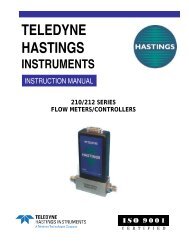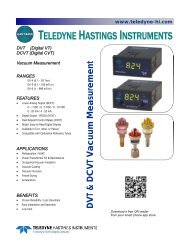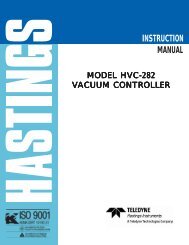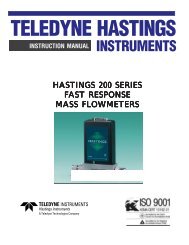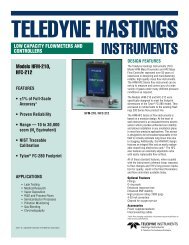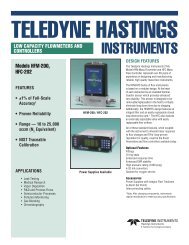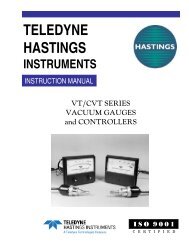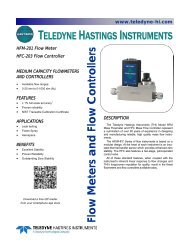HFM-401/405 - Teledyne Hastings Instruments
HFM-401/405 - Teledyne Hastings Instruments
HFM-401/405 - Teledyne Hastings Instruments
You also want an ePaper? Increase the reach of your titles
YUMPU automatically turns print PDFs into web optimized ePapers that Google loves.
6. Appendices6. Appendices6.1. Appendix 1- Volumetric versus Mass FlowMass flow measures just what it says, the mass or weight of the gas flowing through the instrument.Mass flow (or weight per unit time) units are given in pounds per hour (lb/hour), kilograms per sec(kg/sec) etc. When your specifications state units of flow to be in mass units, there is no reason toreference a temperature or pressure. Mass does not change based on temperature or pressure.However, if you need to see your results of gas flow in volumetric units, like liters per minute, cubic feetper hour, etc. you must consider the fact that volume DOES change with temperature and pressure.A mass flow meter measures MASS (grams) and then converts mass to volume. To do this the density(grams/liter) of the gas must be known and this value changes with temperature and pressure.When you heat a gas, the molecules have more energy and they move around faster, so when theybounce off each other, they become more spread out, therefore the volume is different for the samenumber of molecules.Think about this:The density of Air at 0° C is 1.29 g/literThe density of Air at 25C is 1.19 g/literThe difference is 0.1 g/liter. If you are measuring flows of 100 liters per minute, and you don’t use thecorrect density factor then you will have an error of 10 g/minute!Volume also changes with pressure. Think about a helium balloon with a volume of 1 liter. If youcould scuba dive with this balloon and the pressure on it increases. What do you think happens to theweight of the helium? It stays the same. What would happen to the volume (1 liter)? It would shrink.Why is the word standard included with the volume terms liters and cubic feet in mass flowapplications?A mass flow meter measures mass …and we know we can convert to volume.To use density we must pick one (or standard) temperature and pressure to use in our calculation.When this calculation is done, the units are called standard liters per minute (SLM) or standard cubicfeet per minute (SCFM), etc because it is referenced to a standard temperature and pressure when thevolume is calculated.Using the example to the left, we can see astandard liter can be defined differently. Thefirst balloon contains 0.179 grams of Helium at0 ° C and 760 Torr (density of 0.179grams/liter). Heat up that balloon to roomtemperature and the volume increases, but themass has not changed – but the volume is not 1liter anymore, it is 1.08 liters.So to define a standard liter of Helium at 25 C,we must extract only one liter from the secondballoon and that liter weighs only 0.175 grams.If a mass flow meter is set up for STP at 0 C and1 Liter 1.08 Liter 1 Liter760 Torr, when it measures 0.179 grams of He,it will give you results of 1 SLM.0° C25 C25° C0..179 grams/1 0.179 g/1.08 0.164 grams If a second meter is set up for STP at 25 C andliterliters760 Torr, when it measures 0.164 grams, it willgive results of 1 SLM.<strong>401</strong>-<strong>405</strong> SERIES - 24 -



